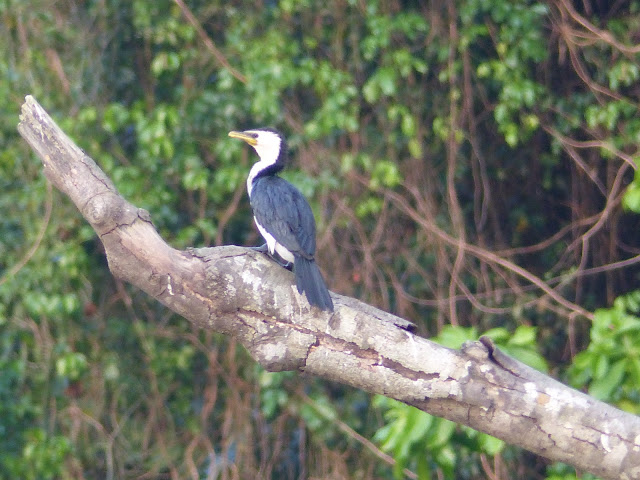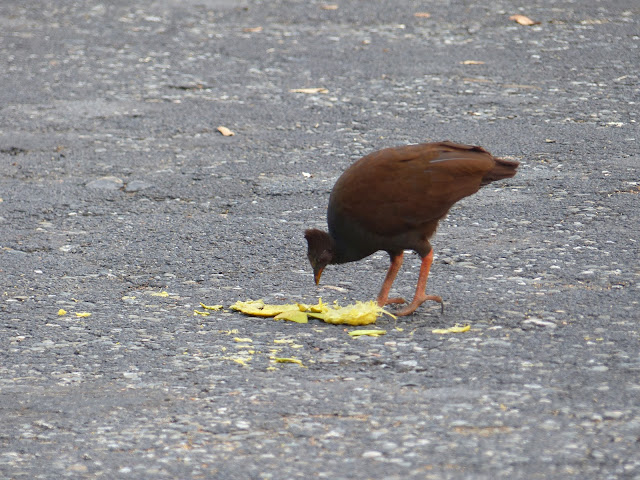- We left Boston on Sunday, October 8, in the early afternoon. Flew to Los Angeles (6 hours) and then to Fiji (10 more hours). We arrived in Fiji very early in the morning of Tuesday, October 10. October 9 never happened - we missed it completely.
- Spent two nights on Fiji, at First Landing Beach Resort & Villas (with a day trip to the South Sea Island on the day in between), and then on October 12 flew to Sydney.
- Two nights in Sydney, at Adina Apartment Hotel, Darling Harbour. Spent the days just getting the feel of the city. We liked it very much.
- On the morning of Saturday, October 14, drove to the Blue Mountains. (We rented the car as soon as we arrived at Sydney airport; this was the first of our three car rentals.)
- First stop at the Blue Mountains: Katoomba Scenic World. Took the "train" down, walked the trails, then rode the cable car back up. Had lunch there and continued towards Jenolan Caves.
- Spent the night at the Jenolan Caves House. In the evening, took the night tour of Jenolan Caves. Walked the trails around the hotel, saw our first wallabies and other wildlife. The hotel is very nice and old-fashioned, great service.
- On Sunday, October 15, drove back through the Blue Mountains (stopping at the Echo Point Lookout to see the Three Sisters up close) and ended up at Bondi Beach. Took a walk along the cliffside towards Bronte Beach, where we went swimming "between the flags". Spent the night at Bondi 38 Apartments in Bondi Beach.
- On Monday, October 16, flew to Cairns. Rented our second car and drove to Port Douglas.
- Spent two nights in Port Douglas, at the Oaks Port Douglas Resort. Spent the day in between on a snorkeling tour of the Great Barrier Reef.
- For the next three nights, moved to Trinity Beach, where we stayed in a beachfront apartment. From there, one day drove North to Daintree Village, to take a boat tour on the Daintree River, and spent another day in Kuranda. Took a train there and a cable car back. Also spent one evening exploring Cairns, which turned out to be a very nice place.
- On Saturday, October 21, flew to Melbourne. That day turned out to be a total loss, because they managed to forget my suitcase in Cairns (how do you even forget to load a whole cart of suitcases on a plane!? on a direct flight!) - anyway, we left Cairns early in the morning, arriving to Melbourne around 2pm, but then while we a) waited for them to locate the suitcase, b) filled out a claim, so that they could bring it to us the next day, and c) waited for the shuttle to the car rental place and got the rental car - lesson learned, check that the car rental place is actually AT the airport - anyway, by then the mansion that we planned to tour that day was already closed, plus we needed to find a store still open at that hour to get at least a raincoat (because all my clothes and both our raincoats were in my suitcase). The weather in Melbourne was 50s, plus rain promised for tomorrow, while I stood in whatever I wore in tropical Queensland, with just one sweatshirt that I took on board airplane in case it would be over-air-conditioned... We managed to find a Target in Geelong and bought me a raincoat, which came very handy the next day (Alik refused and sported a cotton shirt over a sweater, but fortunately the rain was not very strong, just a drizzle).
- We spent that first night, Saturday to Sunday, at Chianti Cottages in Torquay, where we basically just went to bed. Checked out in the morning and drove to Lorne, where we were staying the next two nights at Lorne Surf Apartments. (And where I reunited with my suitcase.)
- Lorne was where we saw most of the wildlife. We had a picnic on the beach, went on a long trail around Lorne (25 thousand steps), drove to Lake Elizabeth at dusk to see a platypus. The drive was about 40 minutes each way, and we managed to see a fox on the way there and an untold number of kangaroos and wallabies on the way back.
- Checked out from Lorne Surf Apartments on Tuesday, October 24. Drove down to Cape Otway Lighthouse, then came back to Apollo Bay, where we spent the next night at the Apollo Bay Waterfront Motor Inn. While there, also went up to the Marriners Lookout and down to the pier, where we saw a huge white Manta Ray in the water.
- The Great Ocean Road technically starts in Torquay and ends in Port Fairy, but its most famous stretch is the so-called "12 Apostles" (although there was never 12, and now there is only 7 or 8 remaining) and the Loch Ard Gorge area. This is the stretch we did all day of October 25 and ended in Warrnambool, at the Logans Beach Whale Nursery Apartments.
- On Thursday, October 26, we abandoned the rest of the Great Ocean Road and drove from Warrnambool to the Budj Bim National Park (where we got to see a real koala in the wild!) and then to Ballarat.
- Ballarat was the capital of the Australian Gold Rush, which took place in the middle of the XIX century. When the gold faded out, so did the city, and it is now a well-preserved example of Victorian-era architecture. We spent one night there at the Ballarat Premier Apartments, and on the morning of Friday, October 27, continued on to Yarra Valley (stopping along the way at the Kinglake National Park, to see lyrebirds - with no luck).
- Yarra Valley is their wine country, so I booked a bungalow for one night at De'Vine Escape, with three wine tastings happening within walking distance of the place. This idea didn't quite work out, but we did spend a nice time walking among the vineyards and birdwatching.
- The next morning, October 28, we drove down to Philip Island, also for one night. We stayed at an apartment there in the private reserve near Smith Beach. Philip Island is where they have the "Penguin Parade", but we decided against it for a variety of reasons. We had a good time exploring the island, which has beautiful views and lots of wildlife.
- On Sunday, October 29, we drove to Melbourne and spent the next three nights at Adina Apartment Hotel there (not to be confused with the one where we stayed in Sydney, at the beginning of our trip). This is a local chain. They are nice, except for some reason you have to use your room key card to ride in the elevator. Very annoying.
- In Melbourne, we went to the Botanical Garden, Shrine of Remembrance, walked around the city, tried the National Gallery (there was nothing there, they were getting ready for a bicentennial or something, so the exposition was in flux), and ended up at the SkyDeck, an observation deck on the 88th floor with panoramic views of the city.
- On Wednesday, November 1, we flew back to Sydney, didn't rent a car, and stayed at Meriton Suites Campbell Street (on the edge of Chinatown) for two more nights. We had an "altitude suite" with a balcony and nice views, but between the two places, I would recommend staying at Darling Harbour. That place is alive!
- On Friday, November 3, we reversed our route, flying through Fiji to Los Angeles, staying overnight in a hotel near the airport, and then flying to Boston on November 4.
Saturday, November 4, 2023
Australia 2023
Friday, November 3, 2023
Australian Birds
In order of appearance, more or less...
White-Faced Heron
We saw the first one on our very first day in Fiji. Then we saw them again in a couple of places in Australia:
- Near Lorne
- In Apollo Bay
Myna
There were tons of them everywhere: starting in Fiji and all around Australia. These birds are native to southern Asia, but they are widespread in other parts of the world, as well (where they are considered invasive species). Before this trip, I saw them in Israel.
Red-Vented Bulbul
We saw them in Fiji, both at the resort and (especially) during our day trip to South Sea Island. They are also native to India, and are considered an invasive species in Fiji.
Pacific Swallow
Also in Fiji, during our trip to South Sea Island.
Welcome Swallow
And just to keep them together, here is another kind of swallow, on the bank of Yarra River in Melbourne.
Laughing Kookaburra
The first really Australian bird! And really cool, too... We saw this one in Manly, near Sydney.
And then saw another one in Lorne.
Australian Darter
And this one is a female, which we saw on our boat trip in Kuranda.
Pied Cormorant
We saw them in several locations in Australia. This photo is from Lorne, on the south coast, but we saw them in Manly, as well.
Little Pied Cormorant
Silver Gull
Superb Lyrebird
Superb Fairy-Wren
Yellow-Faced Honeyeater
New Holland Honeyeater
White-Eared Honeyeater
Noisy Miner
Australian Magpie
Magpie-Lark
Pied Imperial Pigeon
Bush Stone-Curlew
Australian White Ibis
Straw-Necked Ibis
Glossy Ibis
Australian Pelican
Masked Lapwing
Pied Oystercatcher
Little Egret
Cattle Egret
Orange-Footed Scrubfowl
Purple Swamphen
Dusky Moorhen
Eurasian Coot
Green Oriole
Australian Brush-Turkey
Red Wattlebird
Eastern Yellow Robin
Black-Shouldered Kite
Crested Pigeon
Pied Heron
Red-Browed Finch
Parrots!
Rainbow Lorikeet
Sulphur-Crested Cockatoo
Galah
Crimson Rosella
Eastern Rosella
Yellow-Tailed and Red-Tailed Black-Cockatoo
And funnily, just like the Galah chose me at the Wildlife Habitat in Port Douglas, there was a female Red-Tailed Black-Cockatoo who took a strong fancy towards Alik. We were sitting in bleachers, listening to a lecture about koalas, when a large free-flying bird swooped by, landed on a fence next to Alik and started making definite advances towards him.
The zoologist chasing after her explained that she was new, just relocated to the habitat from someplace else, and so she was still unsettled and behaving in unexpected ways. I personally find nothing unexpected in this behavior, to me it shows good taste and sound judgement on her part.




























































































































